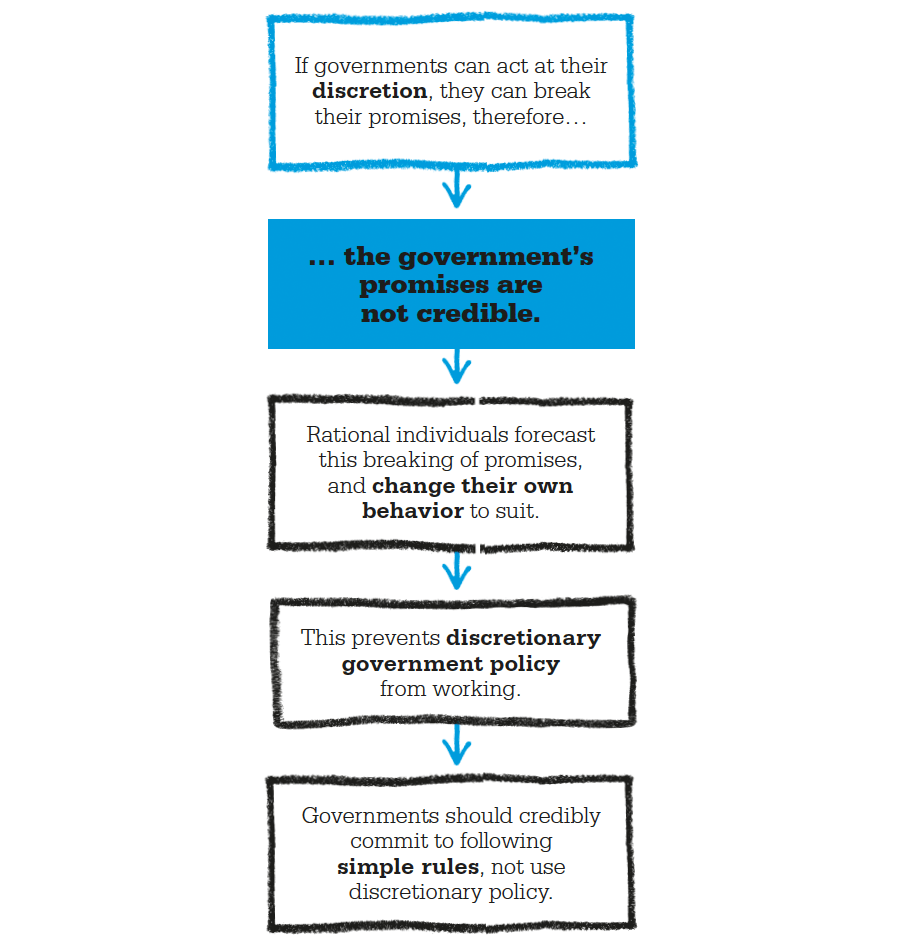

Economic policy
Edward Prescott (1940–)
Finn Kydland (1943–)
1961 John Muth publishes Rational Expectations and the Theory of Price Movements.
1976 US economist Robert Lucas argues that it is naive to model government policy on solutions that have worked in the past.
1983 US economists Robert Barro and David Gordon suggest that high inflation arises from discretionary government policy and propose central bank independence.
From 1980s Independent central banks are established in many countries worldwide and commit to simple policy rules.
Following World War II, economics was dominated by Keynesian thinking. This claimed that governments could maintain high employment through two types of discretionary policies, which are introduced to achieve specific goals through a particular set of actions. The two types of policy used for controlling employment were fiscal policy (government spending and taxation) and monetary policy (interest rates and the money supply).

In 1977, two economists—Finn Kydland of Norway and Edward Prescott of the US—published a paper entitled Rules Rather than Discretion, which argued that discretionary policy was in fact self-defeating. Their argument was based on the concept of rational expectations, which was developed by the US economist John Muth. Muth argued that since having incorrect beliefs about prices is costly, rational individuals seek to minimize their errors by planning ahead to avoid this.
Before this, macroeconomic models had operated on the assumption that individuals only look backward, naively expecting the future to look like the past. The new model predicted that if people collect information and are rational, they can—and will—anticipate government interventions. They then adapt their actions to the government policy they expect, and that policy is in turn rendered less potent. Discretionary policy can only work when individuals are taken by surprise, and it is hard to surprise rational individuals.
To see how this works, imagine a lenient teacher who is trying to make a lazy pupil do his homework. The teacher tells the student that if he doesn’t hand his homework in, he will be punished. But the pupil knows that the teacher is lenient and does not like to punish. The pupil anticipates that if he doesn’t hand in the work, he won’t be punished. Knowing this, he does not do the homework. The teacher’s aim of getting the pupil to hand in his homework is undermined by the pupil’s rational behavior.
Kydland and Prescott said that government promises of low inflation face the same problem. The government does not like high unemployment. So it will boost the economy to keep unemployment low, but this will push up inflation. Like the teacher who threatens a punishment he will not inflict, the government has conflicting aims. Individuals know this and so do not believe the government’s promise of low inflation. This undoes the aim of increasing demand to lead to higher employment, because people know that higher wages will be offset by higher prices. Accounting for rational expectations, the effect of the boost is simply higher inflation.

A government may try to deter the building of homes in a flood-prone area by not subsidizing flood insurance. But if it has bailed people out after a flood in the past, they will not be deterred.
The solution for our teacher would be a compulsory school rule for punishing late homework so he would have to comply. In a similar way Kydland and Prescott proposed that instead of having a free reign to set economic policy, governments should commit to following clear rules. A more radical solution of the teacher’s dilemma would be to delegate punishment-giving to a strict principal. In macroeconomic policy this kind of role can be taken by independent central banks, which place less weight on employment and more weight on low inflation than the government does. Their control of monetary policy allows the government to credibly commit to low inflation. The period of low inflation that arose in the 2000s is often attributed to the rise of independent central banks.

Born on a farm in Gjesdal, Norway, in 1943, Finn Kydland was the oldest of six children. After high school he taught in a junior school for several years, where a fellow teacher suggested he study accountancy, which awakened his interest in business. He started an economics degree at the Norwegian School of Economic and Business Administration (NHH) in 1965. Kydland intended to become a business manager, but after graduation he became an assistant to economics professor Sten Thore, who moved to Carnegie Mellon University, taking Kydland with him. Returning to NHH in 1973, Kydland published his key paper with Edward Prescott. In 1976, Kydland returned to the US, where he has taught ever since. In 2004, he was awarded the Nobel Prize for Economics.
1977 Rules Rather than Discretion (with E. Prescott)
1982 Time to Build and Aggregate Fluctuations
2002 Argentina’s Lost Decade (with Carlos E. J. M. Zarazaga)